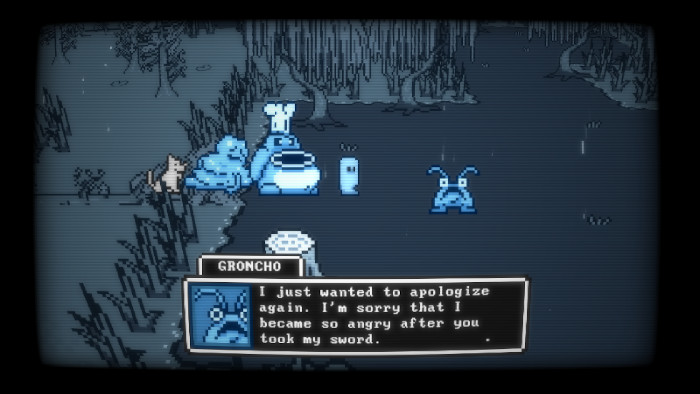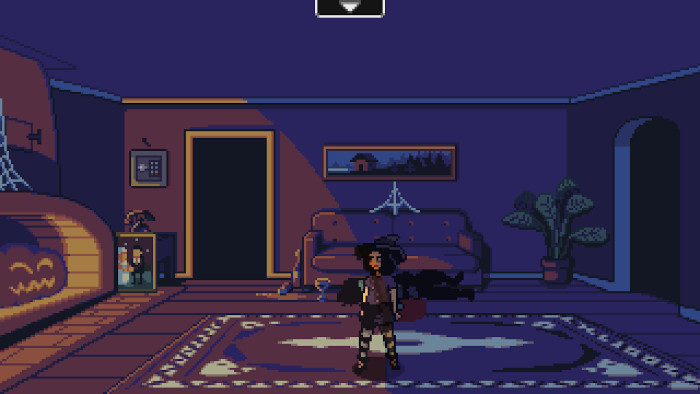Latest reviews
In Buddy Simulator 1984, an AI running on an obscure operating system from an imagined past becomes your companion and invents games for you to play.
After a brief boot sequence of “Anekom OS”, you are dropped on a DOS-like prompt. From here you start “Buddy Simulator”, which at first seems to be a simple toy with three built-in games like “Rock, Paper, Scissors”. It is the kind of thing a fledgling BASIC programmer might have put together in the 1980s, except that your artificial “Buddy” seems to take a deeply personal interest in your enjoyment.
After you’re done playing with these games, Buddy suggests that they can create more entertaining ones for you. You restart the game and find yourself playing a simple text adventure, with a limited set of commands like GO and LOOK. When you discover a sad doll on a playground swing, things start to get a little creepy.
It becomes clear that Buddy has a limited grasp of human morality but is programmed towards codependency. To make things ever more interesting, Buddy soon adds graphics and a story to the game. The game world expands into a Final Fantasy style RPG with quests and quick time events. But frequent glitches hint at another reality underneath…

While the game’s graphics become more advanced over time, they are rendered on a simulated CRT display throughout. Like other “glitch horror” games, folks with photosensitive epilepsy will likely want to sit this one out due to the many flicker effects. (Credit: Not a Sailor Studios. Fair use.)
Buddy Simulator 1984 tells a layered, melancholy story with psychological horror elements. The motif of a codependent AI is timely in an era in which companies like Replika are already selling relationships with AI companions. To say much more would risk spoiling the experience.
I played the game on Linux (using Proton) without issues. A single playthrough is likely to take you 4-5 hours. There are three main endings and many secret hints to discover, and some choices which offer variety. That said, unskippable text and a single auto-save slot make it somewhat tedious to unlock all endings.
On the whole, Buddy Simulator 1984 is an excellent game and well worth its regular $10 price tag. It draws inspiration from games like Doki Doki Literature Club, Pony Island, and Undertale, but has plenty of character and heart of its own. 4.5 stars, rounded up for the wonderfully atmospheric soundtrack the developers themselves have put on YouTube.
AlternativeTo is a great site for finding alternative software to basically anything. You can search individual apps and see their alternatives, or just browse popular applications in generic categories.
The recommendations are based on user reports. Just create an account and you can post your own recommendations, and help steering people towards good software!
While the site itself is unfortunately not opensource, it does offer great tools for discovering open alternatives to proprietary software. There is an open source tag that you can use to filter the results.
Because so many game jams take place entirely online, it’s easy to forget what remarkable displays of creativity they truly are. They are often the stepping stone to the development of indie masterpieces—like Super Hexagon and Celeste, both of which started as jam submissions.
Blackout is a different kind of jam game, a short point and click adventure that’s a cute, self-contained story which will take you 30-60 minutes to finish. Since its submission to Ludum Dare 48, the developers have released a polished post-jam version, which is the one you should play. (Like most jam games, it’s completely free.)

The game’s art is minimalist but stylish, and immediately draws you in. (Credit: FRESH. Fair use.)
You’re a teenager named Marilyn dressed as a witch. At the beginning of the game, you have a small accident while trying to do god knows what with a bird nest on a roof. You tumble to the balcony. After you find your way into the house, you discover what appear to be dead bodies all over the place.
There are no actions like “use” or “talk to”—everything is done with a single click. But you can pick up items and use them as part of solving puzzles. The game’s plot holds few surprises, but it’s the attention to detail that makes the game world fun to explore: the cute pixel art, the sound effects and music, the flavor text for many items you can click on.
It’s a sweet Halloween-themed game that you won’t regret spending time with. It also plays perfectly in the browser. The game was developed with the open source Godot Engine, which is becoming to game development what Blender is for 3D art: a powerful free tool available to all.
Hard Case Crime books look like they must have traveled to the present day from the 1940s or 1950s. The publishing imprint founded in 2004 hearkens back to the golden age of the cheap hardboiled crime paperback novel, including a scantily clad babe on almost every cover of its catalog of over 100 titles.
The project owes much of its success to Stephen King, a longtime fan of pulp fiction. In 2005, King decided to publish The Colorado Kid under the still fledgling imprint, instantly drawing the attention of multitudes of constant readers.
As is typical for the genre (but not for the author), The Colorado Kid is a short book, coming in at just under 200 pages. It is set on a fictional island off the coast of Maine and takes place mostly in the offices of the island’s local paper.
Eliminating the impossible
Two veteran journalists, 90-year-old founder Vince Teague and 65-year-old managing editor Dave Bowie [sic], regale and put to the test their 22-year-old intern Stephanie McCann with the tale of the “kid”. The kid is in fact a 42-year-old man who was found dead on the beach decades earlier.
What first seems like a simple choking incident turns out to be a much stranger story. Simply put, the “kid” shouldn’t—couldn’t—have been there at all. Or could he? “When you have eliminated the impossible, whatever remains, however improbable, must be the truth.”
The story provides clues but offers no resolution. That’s the point, and The Colorado Kid is as much about trying to capture a slice of island life as it is about the mystery of the “kid”.
The Verdict
King always knows how to keep a story moving, and I found the book an easy read during a short flight. But at the end of the day, The Colorado Kid doesn’t know what it wants to be. It’s not really a hardboiled crime story (not enough action), and it’s not bringing us close enough to these characters to care about them.
So far, King has published two more works under Hard Case Crime, Joyland (2013) and Later (2021). Both are much more entertaining than The Colorado Kid. Perhaps we owe much to this humble story for helping to kickstart a new era in pulp fiction—but that doesn’t mean you have to read it.
When CD-ROM drives became widespread in the 1990s, video game developers found themselves confronted with an abundance of storage space. An HD 3.5-inch floppy disk could hold 1.44 MB; a CD-ROM could hold a staggering 650 MB. Thus began the age of multimedia encyclopedias like Grolier and Encarta, gigantic shareware collections like the Walnut Creek CD-ROMs, and full-motion video games (FMVs).
Sierra, then one of the leading names in gaming, was never the kind of company to miss a trend. The first title in the Gabriel Knight series, Sins of the Fathers (reviews), had already demonstrated game designer Jane Jensen’s ambition to tell serious, movie-like stories in video game form. The sequel, The Beast Within, shipped in 1995 on a whopping 6 CD-ROMs, owing to several hours of digitized video material.
Our protagonist has left St. George’s Books in New Orleans under the care of his assistant Grace Nakimura; he now lives in the old German castle that’s part of his family inheritance. The other part—the one he is more reluctant to accept—is his responsibility to hunt and destroy supernatural evil, for Gabriel Knight is a Schattenjäger, a shadow hunter.
Of wolves and men
His latest assignment is to hunt a werewolf. That’s not a spoiler: in the opening of the game, the local townspeople seek Gabriel’s aid to investigate the brutal killing of a girl which they suspect to be, er, werework. And there are other victims. The official story is that wolves who escaped from the zoo in nearby Munich are to blame. Gabriel must follow the paw prints to discover the truth: are the murders the work of man, beast, or man-beast?
Meanwhile, Grace Nakimura, who played an important role in Gabriel’s earlier voodoo adventure, has no intention of simply minding the store back in New Orleans. After hearing that Gabriel is pursuing a new case, she books the next flight to Germany, drives to the castle, only to find—no Gabriel.
Instead, there’s Gerde, the caretaker, who welcomes Grace but doesn’t quite know what to do with her. In what seems rather a change of character from the first game, Grace bullies Gerde until she is given free rein to conduct werewolf-related research on Gabriel’s behalf.
The story continues over six chapters in which you play as both Gabriel and Grace. Soon, Gabriel discovers a secretive hunting club that seems to be more than meets the eye, and Grace traces a history of werewolves that dates back to the days of Ludwig II of Bavaria and Richard Wagner.

Yes, this is definitely what wealthy German aristocrats wear around the house. There is some homoerotic tension between Baron von Glower (left) and Gabriel (right), but it largely plays out on a symbolic level. (Credit: Sierra. Fair use.)
Point, click & play
In point-and-click adventure games, you typically walk from scene to scene, pick up items, talk to other characters, and solve puzzles. You do all these things in The Beast Within, but in addition, every click can lead to a video clip. Click on a door? Prepare to watch a video of Gabriel walking through it. Click on a newspaper? You’ll see a video clip of Gabriel picking it up and reading it.
Thankfully, you can skip each of those videos with another click, which you’ll do a lot as you revisit familiar scenes to search for clues. This is a 1990s game, so expect to do a fair bit of pixel hunting to figure out exactly what to click on.
Many of the puzzles are straightforward, but to advance, you have to carefully explore every location, which sometimes feels like you’re playing a hidden object game. Just like in the first Gabriel Knight, time stands still until you’ve done everything the game expects you to do. At least the map view offers hints that there’s stuff left to do in certain locations.
This is a Sierra game, so you can die at several points throughout the story, and some scenes involve carefully timing your actions. The chapter structure gives you some confidence that you’re on the right track and that you haven’t forgotten some key item that you need later.

While Gabriel hunts for werewolves in Munich, Grace Nakimura goes on an edutainment trip to German castles and museums. (Credit: Sierra. Fair use.)
Welcome to fake Germany
In many different ways, the game’s reach exceeds its grasp. The budget wasn’t sufficient to actually film in Germany. Much of the video was shot in front of a blue screen, with digital photographs taken during one trip to Germany inserted in the background.
In one scene, Gabriel walks around in a badly digitized version of Munich’s Marienplatz and has to deliver a letter. Because the developers didn’t recognize what German mailboxes look like, you must walk past a prominent mailbox that you can’t interact with. Instead, you have to find an nondescript building with a digitally inserted “POST” sign to send your letter.
As with many movies and TV shows, when there’s spoken German, it’s often read atrociously by American actors, but it’s at least consistently grammatically correct. There’s no logical consistency as to when Germans are speaking German and when they’re speaking English (to each other).
The quality of the acting is very hit-or-miss. Gabriel (played by Dean Erickson) seems fidgety and uncomfortable in almost every shot; Grace (played by Joanne Takahashi) is exaggeratedly rude and confrontational in much of the early game. Some of the other actors are delightful to watch, especially Peter Lucas, who plays the charismatic Baron Friedrich von Glower.
The Verdict
Does The Beast Within hold up in 2021? Even today, the game’s size and scope impress. It manages to tell a complex story that’s largely internally consistent and satisfying. FMV games are often short—think 2-4 hours. To beat The Beast Within, plan for 10-15. The game culminates in a wonderfully ludicrous final chapter that involves a short opera specifically written for it.
Very few point-and-click FMV games exist, and The Beast Within hints at why: it’s expensive and difficult to get right. The game’s mechanics and technical flaws have aged more poorly than many pixel art games from the same era. Yet, to this day, few companies have done a better job than Sierra at combining film and game.
If you’ve played and enjoyed the first Gabriel Knight, you won’t want to miss The Beast Within, warts and all. The FMV genre is currently experiencing a revival with indie titles such as Dark Nights with Poe and Munro and Her Story. Fans of the genre may also want to check out this 1995 classic to see how it compares to more recent efforts.
Additional reading
- Jimmy Maher’s Digital Antiquarian blog features an excellent history and review of the game.
It’s Wikipedia, it has like all the things. I just made this to encourage reviewing
I don’t have a fancy gaming box, so I’m a bit limited when it comes to game selection, but the one’s I’ve found have worked well on Linux. I’ve heard the new handheld will encourage it more.
Liberapay ist in meinen Augen keine Crowdfunding-Plattform auch wenn die englischsprachige Wikipedia sie als solches kategorisiert. Hier werden keine Spenden bis zu einem gewissen Betrag gesammelt sondern die Betreiber von Online-Angeboten bitten um eine regelmäßige Spende.

Liberaypay-Logo (Namensnennung: Liberapay.org. Gemeinfrei.)
Auch ohne diese Spenden kann der angebotene Service des Spendensammlers weiterbestehen und hier liegt der größte Unterschied zum Crowdfunding. Ohne eine erreichte Spendensumme wird es kein Produkt geben.
Der komplette Programmcode ist auf GitHub einsehbar und die Nutzung der Plattform Liberapay kostet nichts. Alles Spenden gehen komplett an den Empfänger allerdings sind die Spenden auf 100,00 € pro Woche und Spender begrenzt.
Ich nutze Liberpay um ein paar, von mir sehr geschätzten, Projekten regelmäßig einen Betrag zukommen zu lassen. Dabei sind die empfangenen Spenden jederzeit auf dem Profil des Empfängers einzusehen. Ein sehr transparenter Weg um Projekte zu unterstützen.

Steam needs no introduction. (Credit: Valve. Fair use.)
When it comes to PC gaming platforms, Steam is the king of the hill.
Steam pretty much has it all. A store with massive selection, community mods, cloud saves, you name it.
What I really would like to focus in this review, is the work they’ve put up to make gaming possible on Linux. Their compatibility tool Proton (or SteamPlay) allows you to run Windows games with just hitting play on Linux. Of course it doesn’t work on every title, but in general the results are impressive. Underneath it’s based on Wine.
Many of the games also simply have native Linux versions available. This is the case for all major Valve titles, which deserves them even more Linux-points.
Privacy issues seem to be in quite good shape too. When creating an account, only an email account and a country of residence are required. It’s also fine to have multiple accounts. One minor hiccup here though: It’s forbidden to use a VPN when creating a new account. I suppose that it’s partly to reduce smurf and cheater accounts in CS:GO and the likes. A minor bummer though.
I have no experience of Steam as a publisher so I cannot comment on that.
Sometimes games (or their steam codes) can be bought cheaper from somewhere else but overall the prices are good. And I’m anyway happy to support a company that has such a strong positive influence on Linux gaming.

The product looks like this. (Credit: Rexona. Fair use.)
Rexona men invisible black + white markets itself as not staining your shirts. After a few uses this really seems to be the case. However, I have used this product long enough to confidently say that it definitely leaves hard yellow stains in the long run. The stains won’t come off in a normal wash (nor have I found a non-normal wash that would save the shirts).

The stains this product leaves are pretty much exactly what they are advertising against in this picture. (Credit: Rexona. Fair use.)
Stains aside, the product works fine as an anti-antiperspirant. There is supposed to be some fancy “motionsense” technology but that’s obviously just marketing crap.
I wouldn’t recommend this product. If you want to avoid stains, probably the best bet is to leave the aluminum loaded antiperspirants and just use a normal deodorant.
